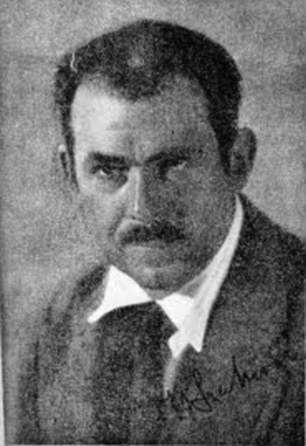1929 (pre): William Seabrook and the Zombies

Seabrook in 1932 [larger version here]
In William Seabrook's 1929 book The Magic Island, Seabrook tells how his Haitian friend Polynice showed the author three actual zombies. Seabrook had been skeptical of a story Polynice had told him about a group of zombies that had returned to their graves accidentally in 1918 (follow the See Also link below), so Polynice decided that Seabrook should meet some current zombies to at least prove that they did exist.
Hence it was that one afternoon Polynice pulled his horse to a stop while he and Seabrook were traveling on a trail to Picmy, Haiti. Polynice pointed to a woman and three men who were working in the fields with machetes, a hundred yards or so off the trail; Polynice was pretty sure it was an older woman named Lamercie he knew who was out working with some zombies, so he ran over to see if he could get permission for Seabrook to examine the men. After a short conversation, Polynice signaled to Seabrook to come join the small group... Polynice was talking with the woman, who looked somewhat unfriendly, while the three men continued to work at cutting the cotton with the machetes.
Seabrook felt uncomfortable immediately; the men's movements as they bent over their work seemed unnatural... machine-like. Polynice touched one of the men on the shoulder, and motioned him to stand; slowly, he rose. The face Seabrook now saw caused a genuine moment of fear and panic; the man's eyes were unfocused and staring at nothing in particular, and the face was completely free of any sort of expression or emotion. Seabrook at once realized he had seen a similar empty expression and felt a similar panic and fear once; he had looked into the eyes of a dog that had the same look. The dog had been part of an experiment at the histological laboratory at Columbia, in which its "entire front brain had been removed." The animal was still alive and could move, but it's face and eyes were empty of all awareness and volition... exactly like the man he now stood in front of.
Seabrook took one of the man's hands, which was rough, and said to the man "Bonjour, compere" ['Hello, friend']. The only response was that Lamercie finally lost her composure and pushed Seabrook away while stating "Z'affai' neg' pas z'affai' blanc"... as Seabrook translated it: "Negroes' affairs are not for whites."
As he and Polynice walked away from this small group, Seabrook decided that the 'zombies' were just people who were deranged or mentally disabled, and that the 'keeper' who worked with them were just guiding their labor. Polynice assured him that beings like this had turned up in Haiti many times over, and had often been recognized by friends and family as people who had died and been buried. Seabrook conjectured that maybe it was just mistaken identities, people's hopes making them believe they re-saw a loved one. Polynice was unimpressed with this thought.
A Final Answer?
Before Seabrook left Haiti, he found himself discussing his experience with a man named Dr. Antoine Villiers. Villiers also agreed that the situation was probably not supernatural, but that it was most certainly unnatural... more so than Seabrook was willing to admit, and closer to what Polynice had told him. Villiers stated that some of the zombies who were toiling in the fields may very well have been retrieved from graves where their families had buried them, as Polynice asserted. Then he showed Seabrook an odd law in the Haitian criminal code... Seabrook translated it as:
Also shall be qualified as attempted murder the employment which may be made against any person of substance which, without causing actual death, produce a lethargic coma more or less prolonged. If, after administering of such substances, the person has been buried, the act shall be considered murder no matter what result follows.
The implication was simple: it was a legally recognized criminal practice in Haiti to poison people into a semblance of death, and to poison them to keep them in a 'lethargic state'... likely performing a chemical equivalent to the "entire front brain" removal experienced by the dog Seabrook had once seen.
Anomalies -- the Strange & Unexplained, as well as my other website -- Monsters Here & There -- are supported by patrons, people like you! All new Anomalies articles are now posted for my patrons only, along with exclusive content made just for them. You can become a patron for just $1 a month!
|








